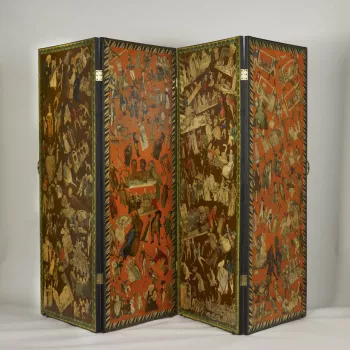Satirical Prints
Satirical prints were Rowlandson’s main source of income. He produced both political and social satires and sometimes adapted the work of earlier artists such as William Hogarth. Satirical prints were available plain, or coloured with watercolours by specialists who painted prints for a living. Uncoloured prints were usually sold for 1 shilling while coloured prints cost 2 shillings.
Such prints were placed by collectors in albums or portfolios, which were often passed around for entertainment after dinner. Prints could also be pasted to walls and screens. Cutting and pasting prints was considered a genteel pastime for ladies or gentlemen. Those who did not have the time or interest to do so themselves could buy furniture ready-decorated.
George, Prince of Wales (b. 1762), later Prince Regent (1811 – 20) and George IV (1820 – 30), was one of the most prolific collectors of satirical prints, acquiring thousands of examples. His collection was augmented in the reign of Queen Victoria (r. 1837 – 1901) when the Queen and Prince Albert made wide-ranging purchases of satirical prints for the Royal Library.








